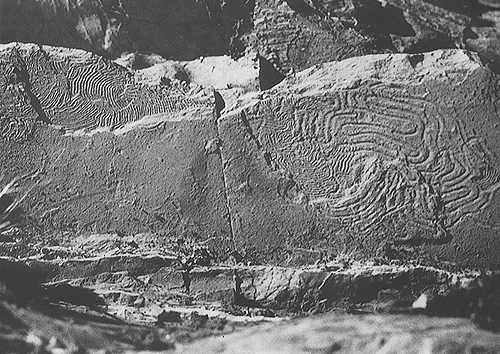
Helminthoid traces
Plate 157

Helminthoid traces
Plate 157
The Linnean name of this structure (Helminthoidea labirinthica ) reveals that it was regarded by paleontologists as a body fossil, although of uncertain classification (incertae sedis ). The relief is modest, and the trace seems engraved on stone. Actually, it represents the track of an animal grazing a muddy bottom in a systematic way, more or less in the style of Zoophycos but without penetrating under the surface. Crossings and overlaps are absent, or almost so. The sediment is a pelagic marlstone, deposited at a bathyal or abyssal depth.
Helminthoids record the maximum depth of water (probably abyssal) among fossil traces, and are found in turbidite formations of the Alpine chains. These units, mostly of Late Mesozoic age, are collectively called "Helminthoid flysch" and crop out in tectonically displaced positions, in connection with compressive structures (thrust sheets). The compression produced by continental collision between Europe and Africa detached and uprooted piles of turbidites from their original substrate and formed the slices that are called thrusts (see also plate 1). A peculiarity of "Helminthoid flysch" units is that the turbidites are mainly calcareous, and individual beds often reach enormous sizes (megabeds). Intrabasinal carbonate detritus, formed by the microscopic tests of planktonic organisms, is supposed to have fed turbidity currents in the first place. The basement of the Helminthoid basins was probably constituted by oceanic crust (the western branch of the Tethys, which vanished at the end of the Mesozoic era or at the beginning of the Cenozoic).
Helminthoid Flysch, Cretaceous, western (French) Alps.